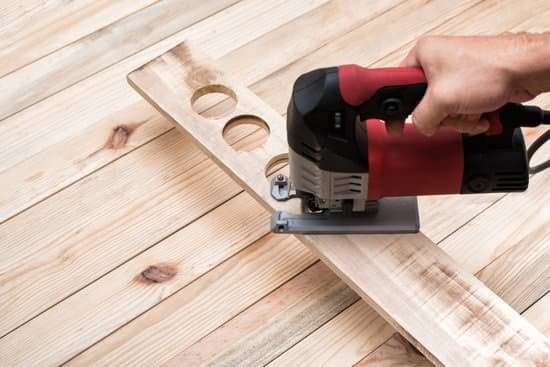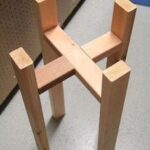Is your furry friend causing damage to your woodwork with their chewing habits? If so, you’re not alone. Many dog owners struggle with this issue, but there are effective strategies for preventing and managing it.
In this article, we’ll explore the reasons behind why dogs chew on woodwork and provide practical solutions to keep your home intact. From training techniques to environmental management and the use of deterrents, we’ll cover everything you need to know to enjoy a chew-free home with your dog.
Understanding the Problem of Dog Chewing is crucial in addressing this common issue among pet owners. Dogs have a natural instinct to chew, but when they turn their attention to your woodwork, it can become a destructive behavior that needs to be addressed. By gaining insight into why dogs engage in this behavior, you’ll be better equipped to implement effective solutions that will benefit both you and your furry companion.
In the following sections, we’ll delve into various methods for preventing dog chewing on woodwork. From training techniques and environmental management strategies to providing mental and physical exercise for your dog, we’ll explore how to redirect their chewing behavior and keep them occupied with appropriate alternatives. With consistency, patience, and the right approach, you can create a harmonious living environment where your dog can thrive without damaging your woodwork.
Why Do Dogs Chew on Woodwork?
Dogs are known for their chewing behavior, and woodwork seems to be a particular favorite for many canines. Understanding why dogs chew on woodwork is important in order to address this behavior effectively. One reason dogs chew on woodwork is that it’s a natural instinct for them.
Chewing helps relieve stress and anxiety, keeps their teeth clean, and provides them with mental stimulation. Additionally, puppies may chew on woodwork as they are teething and need something to soothe their sore gums.
Another reason dogs may chew on woodwork is that they are seeking attention or trying to alleviate boredom. Dogs are social animals and they crave interaction with their owners. If they feel neglected or bored, they may turn to chewing on woodwork as a way of getting attention or entertainment.
In addition, some dogs may chew on woodwork out of curiosity or simply because it tastes good to them. Wood has an appealing texture and taste for some dogs, especially if the wood has absorbed tasty flavors or food spills over time.
It’s essential to understand these reasons why dogs chew on woodwork in order to effectively address and prevent this behavior in our furry friends.
| Reasons Why Dogs Chew | Solution |
|---|---|
| Stress relief, teeth cleaning, mental stimulation | Provide appropriate chew toys and alternatives |
| Seeking attention or alleviating boredom | Ensure mental and physical exercise; create a chewing-free zone |
| Curiosity or appealing taste of the wood | Use bitter apple spray or other deterrents; provide appropriate chew toys |
Training Techniques to Redirect Chewing Behavior
Chewing is a natural behavior for dogs, but when it comes to woodwork and furniture, it can become destructive. So, how to keep dogs from chewing on woodwork? The key is to redirect their chewing behavior towards more appropriate items.
One effective training technique is positive reinforcement. When you catch your dog chewing on something they shouldn’t be, calmly redirect them to an appropriate chew toy or bone. Once they start chewing on the correct item, praise and reward them with treats. This will teach them what is acceptable to chew on and what is not.
Another technique is to use a command such as “leave it” or “drop it”. By teaching your dog these commands, you can interrupt their chewing behavior and redirect them to something else. It’s important to be consistent and patient with this training, as it may take some time for your dog to understand and follow these commands consistently.
Additionally, providing mental and physical exercise for your dog can help decrease their urge to chew. A tired and mentally stimulated dog is less likely to engage in destructive behaviors such as chewing on woodwork. Making sure your dog gets enough exercise through walks, playtime, and even puzzle toys can help prevent unwanted chewing incidents.
| Training Technique | Description |
|---|---|
| Positive Reinforcement | Redirecting chewing behavior towards appropriate items using praise and treats. |
| Use of Command Words | Teaching the dog commands like “leave it” or “drop it” to redirect their chewing behavior. |
| Physical and Mental Exercise | Ensuring the dog gets enough exercise and mental stimulation to decrease the urge to chew. |
Environmental Management
Designating Restricted Areas
One of the most effective ways to keep dogs from chewing on woodwork is to create designated areas where they are not allowed to go. This may include using baby gates or barriers to block off certain rooms or areas of the house where woodwork is present. By limiting your dog’s access to these areas, you can minimize the opportunities for destructive chewing behavior.
Removing Tempting Objects and Materials
Another important aspect of creating a chewing-free zone is to remove any tempting objects or materials that may encourage your dog to chew on woodwork. This includes keeping shoes, slippers, and other personal items out of reach, as well as avoiding leaving wooden furniture or molding exposed and accessible. By eliminating the temptation, you can help prevent your dog from developing a habit of chewing on woodwork.
Providing Alternative Surfaces for Chewing
In addition to restricting access to woodwork, it’s important to provide alternative surfaces for your dog to chew on. This can include durable chew toys, rope toys, or synthetic bones that are specifically designed for teething and chewing dogs. By offering appropriate alternatives, you can redirect your dog’s natural chewing instincts onto more acceptable items while protecting your woodwork from damage.
By implementing environmental management techniques such as creating a restricted area, removing tempting objects, and providing alternative surfaces for chewing, you can effectively create a chewing-free zone in your home and prevent your dog from damaging woodwork. It’s important to be consistent in enforcing these measures and be patient with your dog as they learn new habits. With time and effort, you can enjoy a chew-free home with your beloved canine companion.
Mental and Physical Exercise
Dogs chewing on woodwork can often be a sign of boredom or excess energy. In order to prevent this behavior, it is important to keep your dog mentally and physically active. Providing regular exercise and mental stimulation can help keep your dog busy and distracted, reducing the likelihood of them turning to woodwork for entertainment.
One way to keep your dog mentally exercised is by incorporating interactive toys and puzzles into their daily routine. These toys can help stimulate their minds and prevent them from getting bored, which in turn reduces the likelihood of them seeking out woodwork to chew on. Additionally, taking your dog for regular walks, runs, or engaging them in playtime can help tire them out and keep them from focusing on destructive behaviors such as chewing on woodwork.
Creating a routine that includes mental and physical exercise for your dog can be an effective way to prevent chewing on woodwork. Whether it’s through daily walks, obedience training sessions, or puzzle toys, keeping your dog engaged and stimulated will go a long way in curbing their desire to chew on inappropriate items.
By understanding the importance of mental and physical exercise for dogs, you can effectively address the root cause of their chewing behavior while ensuring they lead happy and healthy lives.
Use of Bitter Apple and Other Deterrents
Bitter Apple and other deterrents are often used to discourage dogs from chewing on woodwork and other items in the home. These products can be effective in deterring a dog’s chewing behavior by creating an unpleasant taste or smell that the dog will want to avoid. However, it is important to use these deterrents properly to ensure their effectiveness.
Choosing the Right Deterrent
There are various deterrent sprays and products available on the market, including Bitter Apple, Grannick’s Bitter Apple, and bitter cherry sprays. It is essential to choose a product that is safe for dogs and does not contain any harmful chemicals. Consult with a veterinarian or professional dog trainer to find the best option for your pet.
Applying Deterrents
When using bitter apple or other deterrents, it’s crucial to apply them correctly. Spray or apply the product onto the areas of woodwork that your dog tends to chew on, such as furniture legs, door frames, or baseboards. Be sure to follow the manufacturer’s instructions for application and reapplication of the product.
Considerations When Using Deterrents
While using bitter apple and other deterrents can be helpful in preventing dog chewing, it’s important to address the underlying cause of the behavior as well. Combine the use of deterrents with positive reinforcement training techniques and environmental management strategies for best results in stopping your dog from chewing on woodwork.
By using bitter apple and other deterrents along with positive reinforcement training techniques and environmental management strategies, you can effectively keep your dog from chewing on woodwork and maintain a chew-free home environment. Remember that consistency and patience are key when implementing these methods, so stay committed to redirecting your dog’s chewing behavior for long-term success.
Providing Appropriate Chew Toys and Alternatives
When it comes to preventing dogs from chewing on woodwork, one of the most effective methods is providing appropriate chew toys and alternatives. This not only satisfies your dog’s natural urge to chew but also helps divert their attention away from your wooden furniture and trim. Here are some chew toys and alternatives that can help keep your dog entertained and away from destructive chewing:
- Rubber Chew Toys: Consider investing in durable rubber chew toys that are specifically designed for aggressive chewers. These toys provide a safe and satisfying outlet for your dog’s chewing instincts.
- Nylon Bones: Nylon bones are another great option for dogs who love to gnaw on hard surfaces. They come in a variety of sizes and textures, making them suitable for different breeds and chewing preferences.
- Rope Toys: Rope toys provide both a chewing and interactive play experience for dogs. The fibers help clean teeth and massage gums, while the act of tugging and pulling can keep your dog engaged and entertained.
In addition to chew toys, providing appropriate alternatives to woodwork can also be effective in preventing unwanted chewing behavior. For example:
- Wooden Chew Blocks: Introduce specially made wooden chew blocks or sticks that are safe for your dog to gnaw on. These blocks can mimic the texture of wood without causing any damage to your furniture.
- Frozen Treats: Offer frozen treats or ice cubes as an alternative for your dog to chew on. Not only does this keep them occupied, but it also provides relief for teething puppies or soothes the gums of older dogs.
By incorporating these chew toys and alternatives into your dog’s daily routine, you can effectively discourage them from indulging in destructive chewing habits while keeping them mentally stimulated and satisfied.
Ultimately, providing appropriate chew toys and alternatives is a crucial aspect of preventing dogs from chewing on woodwork. It’s important to select options that cater to your dog’s specific breed, size, and chewing preferences in order to effectively redirect their natural urge to gnaw towards more suitable items. With patience, consistency, and the right tools at hand, you can enjoy a harmonious living space with your beloved canine companion minus the worry of damaged woodwork.
Consistency and Patience
Preventing dog chewing on woodwork can be a challenging task, but with consistency and patience, it is possible to redirect your dog’s behavior. Here are some tips on how to keep dogs from chewing on woodwork:
- Consistent Training: Consistency is key when it comes to training your dog not to chew on woodwork. Use positive reinforcement techniques such as rewards and praise when your dog chews on appropriate items like chew toys and discourage chewing on woodwork by redirecting their attention.
- Patience: It’s important to have patience when trying to prevent your dog from chewing on woodwork. Understand that changing your dog’s behavior takes time, and it’s essential to remain patient throughout the training process. Reacting with anger or frustration will only confuse your dog and may exacerbate the problem.
- Supervision: Keep a close eye on your dog, especially during the training phase. If you catch them in the act of chewing on woodwork, calmly redirect their behavior towards an appropriate chew toy. By consistently supervising your dog, you can effectively teach them what is acceptable to chew on and what is not.
Conclusion
In conclusion, understanding why dogs chew on woodwork is crucial in addressing this behavior. Whether it’s due to teething, anxiety, boredom, or simply a natural instinct, there are effective training techniques and management strategies that can help prevent your dog from damaging your home. By redirecting their chewing behavior towards appropriate toys and providing mental and physical stimulation, you can keep your dog occupied and satisfied.
Environmental management is also key in creating a chewing-free zone for your dog. By using barriers, bitter apple spray, or other deterrents, you can protect your woodwork and teach your dog what is off-limits. Consistency and patience are essential in this process, as changing a dog’s behavior takes time and effort. It’s important to remain dedicated to the training techniques and environmental management strategies in order to see lasting results.
By implementing these tips on how to keep dogs from chewing on woodwork, you can enjoy a chew-free home with your furry friend. Providing appropriate chew toys and alternatives, engaging in regular exercise, and consistently reinforcing positive behaviors will not only protect your woodwork but also strengthen the bond between you and your dog. With dedication and patience, you can create a harmonious living environment where both you and your dog can coexist happily.

Hi everyone! I’m a woodworker and blogger, and this is my woodworking blog. In my blog, I share tips and tricks for woodworkers of all skill levels, as well as project ideas that you can try yourself.





